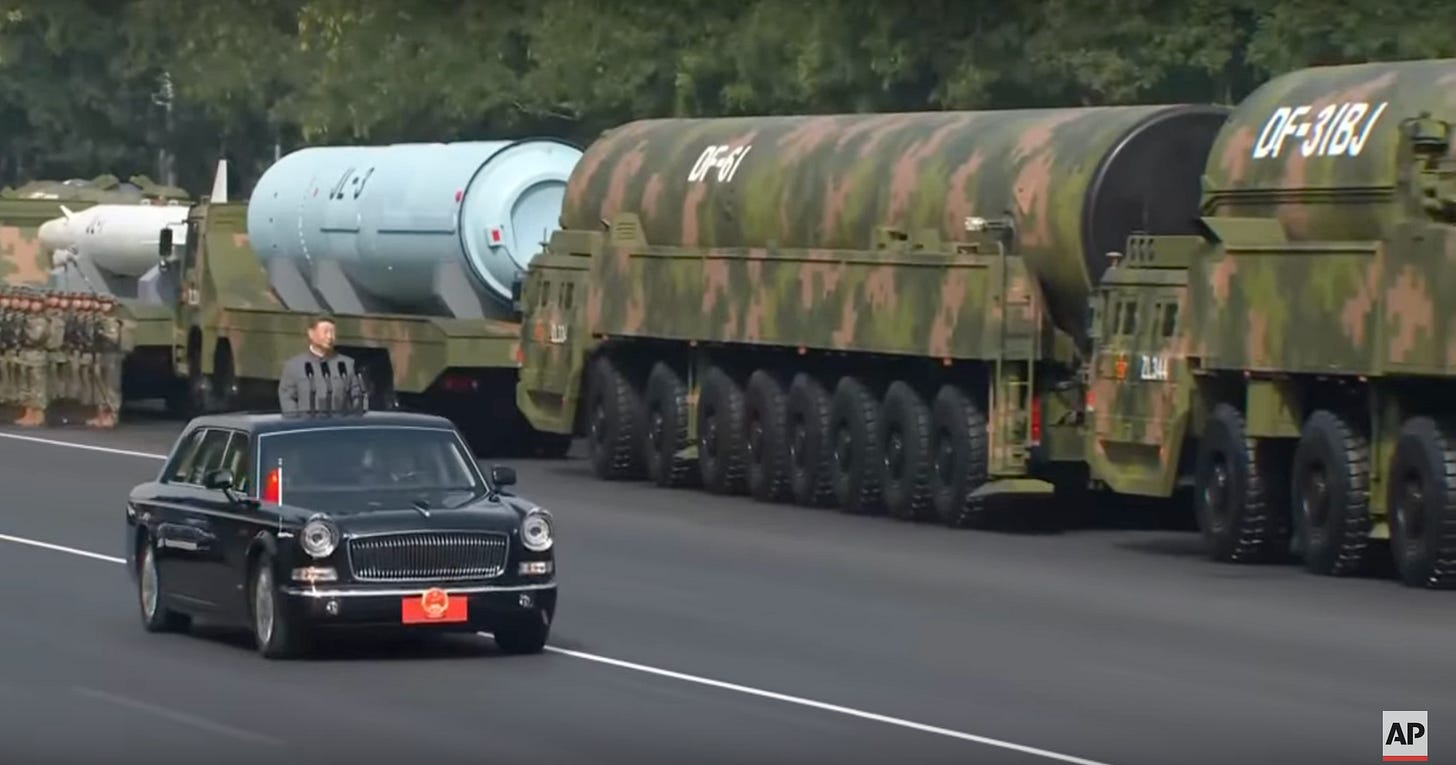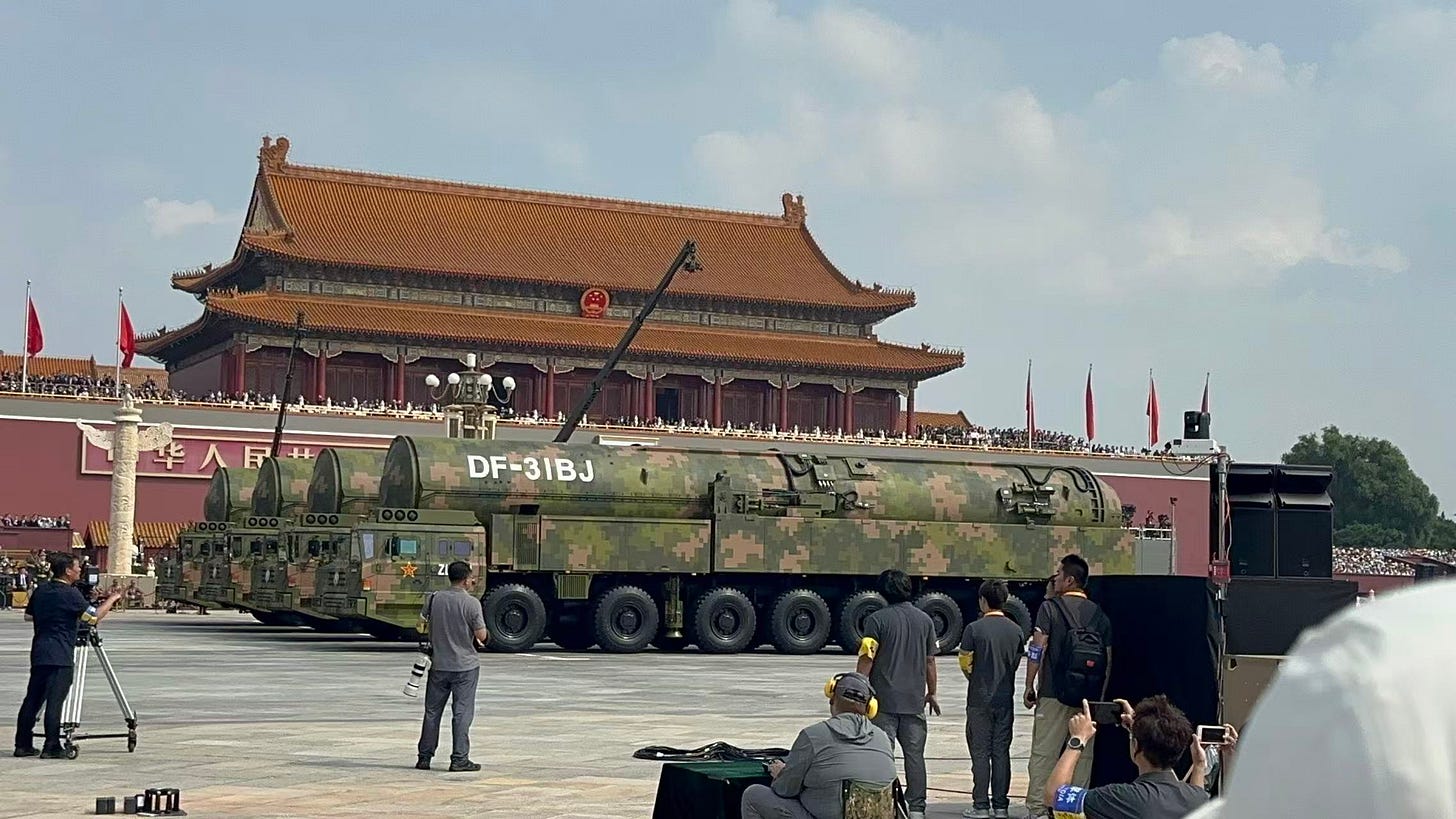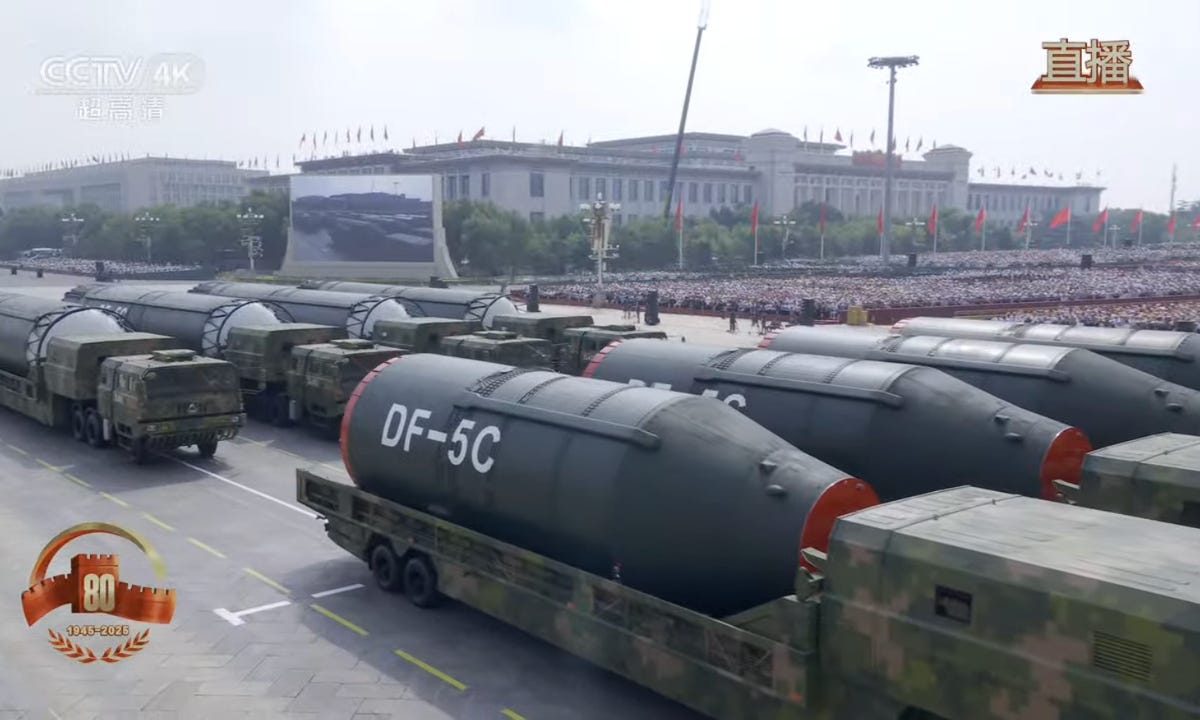Asia Communique — Beijing Victory Day Parade
China Unveils Next-Gen Missiles at V-Day Parade, Showcasing Global Strike Capabilities | Taiwan’s Narrative Clash Over WWII Anniversary Parade |
Beijing Victory Day Parade: A Showcase of China’s Next-Generation Weaponry
On 3 September 2025, a grand military parade was held at Tiananmen Square in Beijing to commemorate the 80th anniversary of Japan’s surrender in World War II. Chinese President Xi Jinping presided over the event, with Russian President Vladimir Putin and North Korean leader Kim Jong-un in attendance. Several Southeast Asian leaders, including representatives from Cambodia, Laos, Thailand, and Myanmar, were also present, alongside select European leaders, such as officials from Hungary, Serbia, and Belarus, while most Western leaders were notably absent.
The 80th anniversary parade holds significant importance for China’s propaganda apparatus, as Beijing seeks to position itself at the center of global politics. In recent weeks, China has intensified its narrative campaign, questioning the U.S. role in World War II while simultaneously amplifying its own contribution to Japan’s defeat.
Overview
China’s Victory Day parade was not just a commemoration of a historic victory; it was designed to project a new image of the People’s Liberation Army (PLA) as a modern, technologically advanced force. Analysts noted that the PLA emphasized system-of-systems operations, integrating optical and radar sensors and airborne early-warning aircraft to counter drones.
The breadth of platforms demonstrated Beijing’s intent to field a full nuclear triad — combining land-based intercontinental ballistic missiles (ICBMs), air-launched weapons from H-6 bombers, and a new JL-3 submarine-launched ballistic missile.
Below is a breakdown of the notable systems showcased, along with analysis of their strategic significance.
New Ballistic Missiles
DF-61 Road-Mobile ICBM
What it is:
The DF-61 is a large road-mobile ICBM carried on a 12-axle transporter-erector-launcher (TEL). Images from parade rehearsals showed canisters marked “DF-61” on 16-wheel TELs. Defense analysts believe it could be a successor to the DF-41, offering better mobility and survivability. The missile may incorporate hypersonic glide vehicles or multiple independently targetable reentry vehicles (MIRVs) and could replace the DF-41 in production.
Implications:
The DF-61’s road-mobile design reduces vulnerability to preemptive strikes. Its potential to carry several MIRVs suggests a significant increase in China’s strategic warhead count, aligning with U.S. assessments that Beijing’s nuclear stockpile will exceed 1,000 operational warheads by 2030. The missile’s appearance underscores a rapid expansion of China’s land-based nuclear forces.
DF-31BJ (Silo-Specific DF-31 Variant)
What it is:
During rehearsals, photographers captured a silo-specific variant of the DF-31 ICBM designated DF-31BJ. Little is publicly known about this missile, but its designation suggests a fixed-silo deployment (“J” likely denotes a specific basing mode).
Implications:
By diversifying the DF-31 family into both mobile and silo-based variants, the PLA Rocket Force can complicate adversary targeting and shorten launch preparation times. According to the Pentagon’s 2024 report on Chinese military power, Beijing is developing new ICBMs to improve its deterrence capabilities.
JL-3 Submarine-Launched Ballistic Missile (SLBM)
What it is:
The JL-3 is China’s third-generation SLBM. It has an estimated range of about 10,000 km, uses solid propellant and astro-inertial/BeiDou guidance, and can carry a 250–1,000 kt nuclear warhead. The missile’s range allows Chinese submarines to strike U.S. targets from waters close to China instead of sailing deep into the Pacific.
How it was portrayed:
Former PLA Colonel Zhou Bo noted that China’s triad now includes sea-launched missiles that rely on stealth, while RAND analyst Raymond Kuo explained that a submarine armed with the JL-3 could approach an adversary’s coast and launch with only five minutes’ warning.
Implications:
The JL-3 enhances China’s nuclear deterrent by closing a critical vulnerability in its triad. It enables continuous at-sea deterrent patrols and reduces the need for China’s submarines to venture far beyond home waters.
DF-5C Intercontinental Ballistic Missile: China’s New Strategic Deterrent
China unveiled the DF-5C, a new liquid-fueled intercontinental strategic nuclear missile, at the V-Day military parade on 3 September 2025, marking the 80th anniversary of Japan’s surrender in World War II. With an estimated range of over 20,000 kilometers, the missile places the entire globe within its strike capability, significantly enhancing China’s nuclear deterrence posture.
According to missile expert Professor Yang Chengjun, the DF-5C integrates technologies from the DF-5 series and the DF-41, offering greater precision, faster response times, and improved defense penetration. The missile features six key advancements: a modular three-section design for quicker deployment, global strike range, versatile launch methods, hypersonic speeds, MIRV capability for multiple warheads, and enhanced guidance accuracy supported by China’s Beidou system.
Despite its capabilities, Beijing maintains that the DF-5C aligns with its defensive nuclear strategy and no-first-use policy, framing the missile as a tool for deterrence and strategic stability, not escalation.
Hypersonic and Anti-Ship Weapons
Hypersonic and Anti-Ship Weapons: YJ-15, YJ-17, YJ-19, YJ-20
China’s parade preview highlighted four new missiles in the YJ (“Eagle Strike”) series, showcasing advancements in hypersonic and anti-ship strike capabilities.
YJ-15: High-Speed Ramjet-Powered Supersonic Missile
The YJ-15 is a ramjet-powered supersonic missile capable of reaching speeds around Mach 3 to Mach 4. This provides the PLA Navy with a high-speed, saturation-attack option designed to overwhelm and penetrate sophisticated enemy air-defense systems.
YJ-17: Hypersonic Glide Vehicle Anti-Ship Missile
The YJ-17 is a hypersonic glide vehicle (HGV) designed for anti-ship operations. Its manoeuvrable glide phase significantly complicates interception attempts and increases the likelihood of bypassing Aegis-class and other advanced naval defense systems, enhancing China’s ability to threaten high-value maritime assets.
YJ-19: Scramjet-Powered Hypersonic Cruise Missile
The YJ-19 employs a scramjet engine, allowing it to cruise at Mach 6 and accelerate to Mach 10 during its terminal attack phase. Its extreme speed and agility make it a formidable “carrier killer”, giving the PLA Navy a potent capability to threaten U.S. aircraft carrier strike groups and other heavily defended naval formations.
YJ-20: Hypersonic Anti-Ship Ballistic Missile
The YJ-20 is a hypersonic anti-ship ballistic missile engineered for precision long-range strikes. It is capable of manoeuvring during descent, making interception more difficult and extending China’s capacity to conduct high-altitude, long-range anti-ship operations across contested waters.
Taiwan’s Narrative Clash Over WWII Anniversary Parade
The 80th anniversary of Japan’s surrender in World War II has triggered a sharp dispute between Beijing and Taipei over historical narratives. China has accused Taiwan of “blaspheming” the sacrifices of those who fought Japan, while Taiwan insists that the Republic of China’s forces — its official designation — carried out the bulk of the combat.
Taipei has urged officials and citizens not to attend Beijing’s military parade, warning of penalties such as pension loss for senior defense, intelligence, and diplomatic personnel who participate. In response, Zhu Fenglian, spokesperson for China’s Taiwan Affairs Office, accused Taiwan of “slandering” the Communist Party’s role as the “backbone” of the resistance, calling Taipei’s stance “a shameless betrayal of the entire Chinese nation.”
The dispute comes amid escalating cross-strait tensions, with Taiwan citing increased Chinese military activity and encirclement drills. President Lai Ching-te emphasized that “unity ensures victory, while aggression inevitably fails,” underscoring Taipei’s rejection of Beijing’s narrative dominance.




